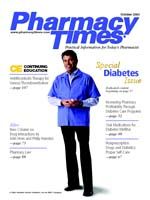Publication
Article
Pharmacy Times
E-Prescribing: Moving Beyond the Prescription Pad
Filling prescriptions must be timely, but it is often a chaotic process. An obstacle that pharmacists face time and again is illegible handwriting on prescription orders. In an effort to simplify the tasks involved in the prescription process, physicians and pharmacists are adopting electronic prescribing (e-prescribing).
The use of e-prescribing holds enormous promise for improving efficiencies and streamlining prescriptions. For example, e-prescribing results in more time for counseling the patient and fewer drug errors. The Institute for Safe Medication Practices believes that e-prescribing could help significantly reduce medication errors. Illegible prescriptions and confusion caused by similar drug names are not uncommon. The authors of a 1999 report from the Institute of Medicine, To Err Is Human: Building a Safer Health System, estimated that prescription errors alone contribute to more than 7000 deaths every year.
Implementing e-prescribing is a huge undertaking. Therefore, members of the National Community Pharmacists Association and the National Association of Chain Drug Stores formed SureScripts in 2001. The goal of this joint venture is to improve the quality, safety, and efficiency of the overall prescribing process. ?As a company, SureScripts is looking at the entire process of prescribing,? said Tammy Lewis, executive vice president of SureScripts.
In August, SureScripts, headquartered in Alexandria, Va, announced the national rollout of SureScripts Messenger Services, a network for e-prescribing connectivity. The rollout began with the launch of an early test program in Rhode Island in partnership with the Rhode Island Quality Institute. More than 50% of the nation?s 55,000 pharmacies will be connected to SureScripts Messenger Services by the end of 2003, according to Lewis. She said that the infrastructure would save several hours of a pharmacist?s day that are now spent communicating with physicians, thereby requiring less time for administrative tasks, improving safety and accuracy, and improving the quality of patient care.
Under the current prescribing system, as many as 450 million of the approximate 3.4 billion prescriptions dispensed annually require physician authorization for additional renewals before they are dispensed, translating to >9 million phone calls and faxes between physicians and pharmacies and costing more than $2 billion annually. Another reason for the need to improve the prescription process is the increasing demand for pharmaceuticals, which has risen by more than 50% since 1992. The 3.4 billion prescriptions handled annually are expected to increase to 4 billion in the next 3 years, according to SureScripts.
?E-prescribing is not new. A big difference now is that the ?e? means electronic. Historically, e-prescribing was by fax, and there was no way to automate it,? said Lewis. SureScripts Messenger Services will allow pharmacists to transmit prescription information to and communicate with physician practices in a 2-way, true electronic format, which eliminates fax, phone, pen, and paper from the prescribing process.
Lewis said that in the beginning some pharmacies will use e-prescribing for automating only the refilling process and then later will incorporate the entire prescription process, whereas other pharmacies will do both automatically.
SureScripts is not the only company offering e-prescribing technology. ProxyMed, based in Fort Lauderdale, Fla, was the first company to adopt the National Council for Prescription Drug Programs (NCPDP) SCRIPT standard, which was developed in 1997. SCRIPT is a data transmission standard intended to facilitate the communication of prescription information between prescribers and pharmacists.
?We are 1 of the pioneers in this field [e-prescribing]. We have survived all the different changes that have taken place, and we remain excited about all the notoriety that e-prescribing has received recently,? said Richard K. Brook, vice president for pharmacy network development for ProxyMed.
In fact, ProxyMed works closely with the NCPDP by participating in work groups and NCPDP meetings, according to Brook. ProxyMed?s e-prescribing technology provides connectivity to more than 30,000 pharmacies and processes more than 3.25 million transactions annually. ProxyMed?s e-prescribing network allows for the transmission of new prescriptions, refill authorization requests, refill authorization responses, change authorization requests, change authorization responses, and stop orders.
ProxyMed has established connectivity with Walgreens, Eckerd, Rite Aid, Publix, and QS/1 Data Systems. Of those 5, Walgreens, Rite Aid, and Publix are using the SCRIPT standard. As of August 2003, ProxyMed was actively e-prescribing in 27 states, with the most activity in Florida, Texas, and Arizona. ?Those states have a critical mass of Eckerd, Walgreens, and Rite Aid or some combination of the 3,? said Brook.
In 2002, ProxyMed and SureScripts signed a collaborative agreement to sponsor and provide e-prescribing services. Furthermore, both companies agreed to interconnect their networks so that the physicians and pharmacists on both networks have seamless and direct access to each other.
The NCPDP is very satisfied with the direction e-prescribing is heading. ?We love e-prescribing. We are happy to see the action that is being taken by various organizations,? said Phillip D. Scott, senior vice president for health care relations and development for NCPDP.
The SCRIPT standard allows anything physicians and pharmacies have done manually to be done electronically, including refill prescriptions, new prescriptions, and verification that a customer has picked up a prescription. Currently, the law has not allowed for controlled substances to be processed using e-prescribing, said Scott. ?We?ve been working with the DEA [Drug Enforcement Agency] and would love for them [DEA] to adopt our standard,? he said.
As for the future of the prescription pad, Scott does not believe that the traditional paper prescription will be eliminated. ?We hope to see the lion?s share of it move in the e-prescribing direction. There are always going to be segments of our industry that will use the prescription pad. It will never eliminate it, and I don?t think it?s practical to think that.?
Although e-prescribing may never completely mean good-bye to handwritten prescriptions, it is changing the face of the pharmacy profession. This change will bring the community pharmacy to a new level of service and allow pharmacists to get back to the business of pharmac - patient counseling.







